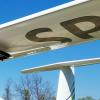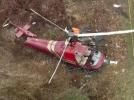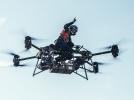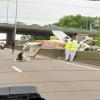Nepal DHC6 at Jomsom on May 16th 2013, runway excursion
The Civil Aviation Authority of Nepal (CAAN) released their final report concluding the probable causes of the accident were:
The Accident Investigation Commission has determined the most probable cause of the accident as the inappropriate conduct of STOL procedure and landing technique carried out by the PIC, during landing phase and an endeavor to carry out take off again with no sufficient airspeed, no required lifting force and non availability of required runway length to roll.
Contributory factors to the occurrence is the absence of proper CRM in terms of communication, coordination and briefing in between crew members on intention and action being taken by PIC, during pre and post landing phase.
The CAAN reported that the captain (39, ATPL, 8,451 hours total, 8,131 hours on type) had been involved in two occurrences prior to the accident, in the first case in 2010 he had "control difficulties in maintaining the desired flight path during landing where exacerbated by illusion, unstable wind condition and improper loading. These contributing factors may have caused the aircraft to bounce three times, resulting this incident." In the second occurrence in 2008 he had invited cabin crew to take the seat of the first officer in flight in violation of procedures, the CAAN stated: "It showed ignorance about the safety."
While descending towards Jomsom, aerodrome flight information service (AFIS) informed the crew about southwesterly winds at 8 to 12 knots, runway 24 was in use. The first officer (29, CPL, 1,396 hours total, 1,202 hours on type) accepted runway 24 reading back they would report on downwind runway 24. Without discussion the captain took communication over from the first officer and requested runway 06, responded to the query by ATC that 8-12 knots were no problem, ATC therefore assigned runway 06 to the aircraft.
A go-around briefing by the captain contained just one word: "standard".
The aircraft was configured for landing with full flaps and touched down on runway 06 776 feet past the runway threshold. About 194 feet after touchdown the aircraft left the runway surface and entered soft ground to the right of the runway with the maximum deviation being 19 feet from the right hand runway edge.
In the meantime the first officer, without communication taking place between the pilots, worked the after landing checklist and retracted the flaps.
While attempting to return the aircraft onto the runway the captain increased engine power with the intention to go around, the aircraft however had already lost a lot of speed due to application of brakes by the captain. Nonetheless, the aircraft accelerated but reached insufficient speed to produce sufficient lift for becoming airborne. The aircraft overran the end of runway 24, continued towards the river, ran through a barbered fence and gabion wall before falling down onto the edge of the river.
The captain, first officer and a female passenger received serious injuries, the flight attendant and 6 passengers received minor injuries, 11 passengers remained uninjured. The aircraft received substantial damage including the right hand wing being sheared off the aircraft.
The CAAN reported the captain gave following post accident interview: "Assuming difficulty to stop I tried aircraft to bring in the runway and added power to airlift the aircraft to avoid the possible overrun in the runway. My calculation did not match with the reality. Aircraft did not produce enough lift and ultimately fell down in the bank of Kaligandaki River. Because of critical state of aircraft and very little time I could not communicate with co-pilot about the intention and actions to be taken."
The first officer provided following testimony: "Approach was stable and landing was normal. Attitude of the aircraft on the runway seemed normal's after landing. While aircraft landed the Ground speed was around 118 KTS. During landing in normal condition the GS should be around 90-95 KTs. The landing speed was higher than normal. Initially PIC applied reverse but aircraft did not control rather diverted to grass area and become unbalanced. As usual practice when pilot applied reverse and brake I had raised flaps up and neutral without consent of pilot. It was difficult to control aircraft even PIC applied full rudder and nose wheel. Immediately after aircraft entered grass area, PIC applied power. After a little time aircraft again entered runway and accelerated. Before applying power the speed of aircraft was around 30-40 KTS. As PIC did not communicate with me about his intention and action to be taken, I did nothing. I was wondering what PIC is doing in such critical situation without informing me. There was no problem in aircraft tire."
The CAAN quoted observers on the ground stating that after the aircraft had veered right onto grassy surface the aircraft sounds changed as if a takeoff was attempted and the speed of the aircraft increased.
The CAAN analysed that according to the first officer's statement the approach speed was more than 100 knots while STOL procedures require an approach speed of 70 knots +/- 5 knots.
The weather, facilities and runway conditions at Jomsom were not contributing factors to the accident.
The aircraft technical and loading condition were not factors into the accident.
The captain was experienced and had been checked out one by one to operate into STOL (short takeoff and landing) aerodromes by the instructor pilots. Nonetheless, the CAAN analysed, "the STOL landing procedure undertaken by PIC and the final decision taken in this flight were inappropriate."
The CAAN analysed that AFIS on STOL aerodromes had been given the authority by Nepalese regulations to declare a runway closed provided there were tail winds in excess of 10 knots.
http://avherald.com/h?article=46259f57/0001














Komentarze